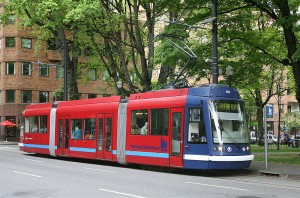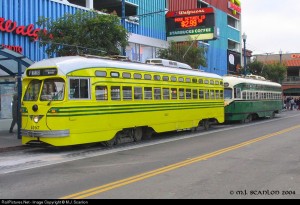Transit 101 is an occasional series that will focus on the history and technology of modern-day public transit systems. To start the series off, we will focus on the various modes of rail transit:
Part I: Streetcars and Interurbans
Part II: Heavy Rail and Light Rail
Part III: Commuter Rail
Part IV: Intercity Rail and High-Speed Rail
Welcome to Transit 101. In this first article of the series, we will explore the history and technical aspects of one of the most basic forms of rail transit, the streetcar and interurban, and by the end of the series, we will have worked our way up to high-speed trains that can traverse hundreds of miles in a matter of minutes.
A Brief History
 Streetcar technology actually began with that most American form of transit in the 19th Century, the stage coach, or omnibus: a passenger coach pulled by a team of horses. Operators soon discovered that, with the decreased friction provided by metal wheels running on metal rails embedded in the streets, the same number of horses could pull a far greater number of passengers. In time, horses were replaced with electric motors powered by overhead wires.
Streetcar technology actually began with that most American form of transit in the 19th Century, the stage coach, or omnibus: a passenger coach pulled by a team of horses. Operators soon discovered that, with the decreased friction provided by metal wheels running on metal rails embedded in the streets, the same number of horses could pull a far greater number of passengers. In time, horses were replaced with electric motors powered by overhead wires.
In most cases, electrical power was provided by a single overhead wire, with the ground return carried through the running rails in the street. Cincinnati’s original streetcar system was unique in that it operated on two overhead wires, one for the electrical supply and the other for the ground return.
A “trolley” at the end of the long metal pole was the contact point between the vehicle and the electrical supply, which slid along the wire and provided power to the vehicle’s motors. This is how streetcars became known as trolleys, although the pantograph — a spring-loaded metal bar — eventually became the standard for conducting electricity from the catenary to the vehicle’s motors. Thus, every trolley is a form of a streetcar, but not every streetcar is a true trolley. The word “trolley” being used in a derisive manner by streetcar opponents belies an ignorance about the historical origins of the term.
The first streetcar line in the United States was the Fourth Avenue Line in New York City, which was operated by the New York and Harlem Railroad (now MTA Metro-North) along Fourth Avenue and the Bowery. Over time, streetcars became the dominant mode of public transit in most American cities, including Cincinnati, Chicago, and Los Angeles. Most streetcar systems operated with two crew members per car: a motorman to drive the vehicle, and a conductor to collect fares (usually in the form of cash or a token). The vast majority of streetcar lines ran in shared traffic on city streets, although there were exceptions. In Fort Thomas, the Green Line streetcar ran on a dedicated right-of-way along what is now Memorial Parkway before reaching the bedroom suburb’s central business district. In Boston, a streetcar tunnel through Back Bay and downtown was built in 1897, separating streetcars from surface traffic and creating America’s first subway line.
In some cases, streetcars acted as modes of transit between cities, running on city streets within the urban area but running on their own rights-of-way through rural areas. These lines became known as interurbans, with the rolling stock often times built larger than typical streetcars, with amenities for intercity travel such as more comfortable seats and on-board lavatories. The oldest surviving interurban line in the United States is the Chicago South Shore and South Bend Railroad, now operating as a commuter railroad, and the concept of the interurban has been somewhat revived and re-branded as “light rail” in recent years. We will explore commuter rail and light rail in future installments of this series.
In 1929, the Electric Railway Presidents’ Conference Committee commissioned the design of a modern, standardized streetcar they hoped would fend off competition from buses and the automobile. The so-called PCC streetcar featured a number of improvements in ride quality over the previous generations of streetcars, and became an icon of 1930’s industrial design. Many PCC streetcars are still in service today throughout the world.
The development of the PCC streetcar proved to be inadequate to stop the forces conspiring to kill streetcar service in most American cities during the post-war era, though. The federal government explicitly favored highway construction and suburban development over public transit, while a front company known as National City Lines served as a means for General Motors, Firestone, and Standard Oil to buy up streetcar lines throughout the United States, dismantle them, and replace the streetcars with buses built by GM.
In Cincinnati, the last streetcar line ceased operation on April 29, 1951. The last Green Line streetcars in Northern Kentucky had been replaced by buses years earlier.
Modern-Day Streetcars
 Although most North American streetcar systems didn’t survive past the 1950’s, there are a few notable exceptions. Toronto, Ontario still maintains and operates eleven streetcar routes. Boston’s Green Line (with its four branches) and Mattapan-Ashmont Trolley are vestiges of the streetcar era in that city; the Green Line has been transformed into a modern-day light rail system, while the Mattapan-Ashmont line still runs PCC streetcars as an extension of the Red Line rapid transit line. Boston’s streetcars survived because they travel in tunnels downtown, where diesel-powered buses cannot operate.
Although most North American streetcar systems didn’t survive past the 1950’s, there are a few notable exceptions. Toronto, Ontario still maintains and operates eleven streetcar routes. Boston’s Green Line (with its four branches) and Mattapan-Ashmont Trolley are vestiges of the streetcar era in that city; the Green Line has been transformed into a modern-day light rail system, while the Mattapan-Ashmont line still runs PCC streetcars as an extension of the Red Line rapid transit line. Boston’s streetcars survived because they travel in tunnels downtown, where diesel-powered buses cannot operate.
Likewise, in Philadelphia, the Subway-Surface streetcar lines travel in tunnels downtown while operating on the surface as trolleys in the outer neighborhoods, while the Media, Norristown, and Sharon Hill lines operate as feeders into the Market-Frankfort rapid transit line at its 69th Street terminal.
Some streetcar lines survived as trolley bus or “trackless trolley” routes, in which buses with rubber tires are powered via overhead electrical lines. Such systems can be found in Dayton, Cambridge, Philadelphia, San Francisco, and Seattle. In Chicago, various components of the old PCC streetcars were reused for the 6000-series rapid transit cars that ran on the ‘L’ system into the 1990’s.
Some cities, notably San Francisco, Tampa, and Kenosha, operate historic “heritage” streetcar lines as tourist attractions. This is in addition to a number of transit and railway museums throughout the country that maintain and operate their own historic streetcar rosters.
In the the late 1990’s and early 2000’s, as the dire consequences of a half-century of automobile-oriented urban policy and development became apparent, planners began to question the wisdom of dismantling the nation’s streetcar systems. Portland, Oregon became the first American city to build a new streetcar line in the post-war period, using articulated low-floor vehicles similar in nature to those used on many light rail lines. The Portland streetcar has been a resounding success story, and the neighboring cities of Tacoma and Seattle have built their own modern streetcar lines.
The success of these new streetcar systems in the Pacific Northwest has sparked interest in cities across the nation, with 22 cities either building or designing new streetcar lines. Among Midwestern cities, Cincinnati is at the forefront of this movement, with most funding now in place and construction expected to begin on our own streetcar line this fall.
Characteristics of the Modern Streetcar
 Modern streetcar systems, such as the Portland streetcar and the streetcar system proposed for Cincinnati, use modern light rail vehicles that are 8′-6″ wide and about 60 feet long, with a passenger capacity of 150-200 people per car. The center two-thirds of the vehicles have a low floor that is even with the platform height, enabling easy boarding by passengers with disabilities. The cars are powered via a single 750V DC overhead wire, which is designed to blend in with the urban context in an unobtrusive manner.
Modern streetcar systems, such as the Portland streetcar and the streetcar system proposed for Cincinnati, use modern light rail vehicles that are 8′-6″ wide and about 60 feet long, with a passenger capacity of 150-200 people per car. The center two-thirds of the vehicles have a low floor that is even with the platform height, enabling easy boarding by passengers with disabilities. The cars are powered via a single 750V DC overhead wire, which is designed to blend in with the urban context in an unobtrusive manner.
On older streetcar systems, fares were paid in the form of cash or a token, and collected on board the vehicle by the motorman or a conductor. On modern systems, fare collection is usually via a proof-of-payment system in which a ticket is purchased and validated before boarding the vehicle. The ticket allows unlimited travel within a certain time period, with enforcement taking place through the use of random spot checks. Portland’s streetcar and light rail systems feature a “Fareless Square” within the downtown core, in which all rides are free.
Unlike other forms of rail transit, streetcars generally operate in mixed traffic, sharing the right-of-way with automobiles, buses, and bicycles. The physical infrastructure for the streetcar is minimal, consisting of the track, power supply, maintenance facilities, and the stations. The stations themselves are usually little more than raised curbs with shelters and ticket vending machines. The following video highlights the Portland streetcar system:
The streetcar, since it operates in shared traffic at relatively slow speeds, is convenient as a neighborhood circulator within a compact urban area, but less effective for regional travel. For longer-distance travel at higher speeds, a dedicated right-of-way and larger vehicles are required. Such rapid transit systems fall into two broad categories, heavy rail and light rail, which we will explore in the next installment of this series.
Update: Due to an extended power outage on Monday and other time commitments, the schedule for the Transit 101 series has been revised. Part II of the series is tentatively scheduled for next Monday, August 23rd, with additional installments appearing each Monday through September 6th.




{ 1 } Trackback
[…] the first installment of this series, we explored the history and technology of streetcars and interurbans, modes of rail transit that are characterized by relatively light passenger capacities that often […]